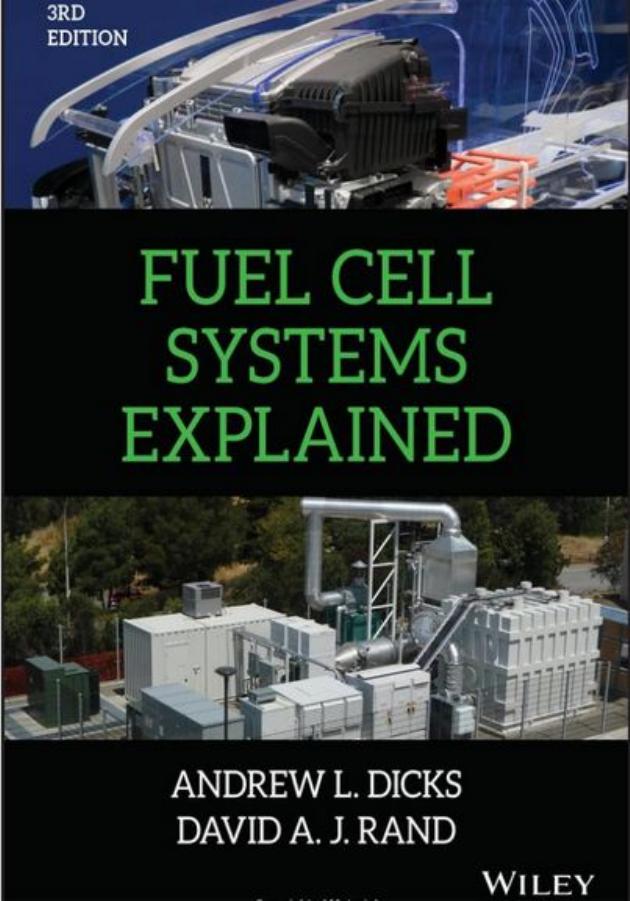Fuel Cell Systems Explained 3rd Edition by Andrew Dicks, David Rand ISBN 9781118706961 111870696X
$70.00 Original price was: $70.00.$35.00Current price is: $35.00.
Instant download Fuel Cell Systems Explained 3rd Wei Zhi after payment
Fuel Cell Systems Explained 3rd Edition by Andrew Dicks, David Rand – Ebook PDF Instant Download/Delivery: 9781118706961 ,111870696X
Full dowload Fuel Cell Systems Explained 3rd Edition after payment

Product details:
ISBN 10: 111870696X
ISBN 13: 9781118706961
Author: Andrew Dicks, David Rand
Since publication of the first edition of Fuel Cell Systems Explained, three compelling drivers have supported the continuing development of fuel cell technology. These are: the need to maintain energy security in an energy-hungry world, the desire to move towards zero-emission vehicles and power plants, and the mitigation of climate change by lowering of CO2 emissions. New fuel cell materials, enhanced stack performance and increased lifetimes are leading to the emergence of the first truly commercial systems in applications that range from fork-lift trucks to power sources for mobile phone towers. Leading vehicle manufacturers have embraced the use of electric drive-trains and now see hydrogen fuel cells complementing advanced battery technology in zero-emission vehicles. After many decades of laboratory development, a global but fragile fuel cell industry is bringing the first commercial products to market. This thoroughly revised edition includes several new sections devoted to, for example, fuel cell characterisation, improved materials for low-temperature hydrogen and liquid-fuelled systems, and real-world technology implementation. Assuming no prior knowledge of fuel cell technology, the third edition comprehensively brings together all of the key topics encompassed in this diverse field. Practitioners, researchers and students in electrical, power, chemical and automotive engineering will continue to benefit from this essential guide to the principles, design and implementation of fuel cell systems.
Fuel Cell Systems Explained 3rd EditionTable of contents:
1 Introducing Fuel Cells
1.1 Historical Perspective
1.2 Fuel‐Cell Basics
1.3 Electrode Reaction Rates
1.4 Stack Design
1.5 Gas Supply and Cooling
1.6 Principal Technologies
1.7 Mechanically Rechargeable Batteries and Other Fuel Cells
1.8 Balance‐of‐Plant Components
1.9 Fuel‐Cell Systems: Key Parameters
1.10 Advantages and Applications
Further Reading
2 Efficiency and Open‐Circuit Voltage
2.1 Open‐Circuit Voltage: Hydrogen Fuel Cell
2.2 Open‐Circuit Voltage: Other Fuel Cells and Batteries
2.3 Efficiency and Its Limits
2.4 Efficiency and Voltage
2.5 Influence of Pressure and Gas Concentration
2.6 Summary
Further Reading
3 Operational Fuel‐Cell Voltages
3.1 Fundamental Voltage: Current Behaviour
3.2 Terminology
3.3 Fuel‐Cell Irreversibilities
3.4 Activation Losses
3.5 Internal Currents and Fuel Crossover
3.6 Ohmic Losses
3.7 Mass‐Transport Losses
3.8 Combining the Irreversibilities
3.9 The Electrical Double‐Layer
3.10 Techniques for Distinguishing Irreversibilities
Further Reading
4 Proton‐Exchange Membrane Fuel Cells
4.1 Overview
4.2 Polymer Electrolyte: Principles of Operation
4.3 Electrodes and Electrode Structure
4.4 Water Management
4.5 Cooling and Air Supply
4.6 Stack Construction Methods
4.7 Operating Pressure
4.8 Fuel Types
4.9 Practical and Commercial Systems
4.10 System Design, Stack Lifetime and Related Issues
4.11 Unitized Regenerative Fuel Cells
Further Reading
5 Alkaline Fuel Cells
5.1 Principles of Operation
5.2 System Designs
5.3 Electrodes
5.4 Stack Designs
5.5 Operating Pressure and Temperature
5.6 Opportunities and Challenges
Further Reading
6 Direct Liquid Fuel Cells
6.1 Direct Methanol Fuel Cells
6.2 Direct Ethanol Fuel Cells
6.3 Direct Propanol Fuel Cells
6.4 Direct Ethylene Glycol Fuel Cells
6.5 Formic Acid Fuel Cells
6.6 Borohydride Fuel Cells
6.7 Application of Direct Liquid Fuel Cells
Further Reading
7 Phosphoric Acid Fuel Cells
7.1 High‐Temperature Fuel‐Cell Systems
7.2 System Design
7.3 Principles of Operation
7.4 Performance
7.5 Technological Developments
Further Reading
8 Molten Carbonate Fuel Cells
8.1 Principles of Operation
8.2 Cell Components
8.3 Stack Configuration and Sealing
8.4 Performance
8.5 Practical Systems
8.6 Future Research and Development
8.7 Hydrogen Production and Carbon Dioxide Separation
8.8 Direct Carbon Fuel Cell
Further Reading
9 Solid Oxide Fuel Cells
9.1 Principles of Operation
9.2 Components
9.3 Practical Design and Stacking Arrangements
9.4 Performance
9.5 Developmental and Commercial Systems
9.6 Combined‐Cycle and Other Systems
Further Reading
10 Fuels for Fuel Cells
10.1 Introduction
10.2 Fossil Fuels
10.3 Biofuels
10.4 Basics of Fuel Processing
10.5 Membrane Developments for Gas Separation
10.6 Practical Fuel Processing: Stationary Applications
10.7 Practical Fuel Processing: Mobile Applications
10.8 Electrolysers
10.9 Thermochemical Hydrogen Production and Chemical Looping
10.10 Biological Production of Hydrogen
Further Reading
11 Hydrogen Storage
11.1 Strategic Considerations
11.2 Safety
11.3 Compressed Hydrogen
11.4 Liquid Hydrogen
11.5 Reversible Metal Hydrides
11.6 Simple Hydrogen‐Bearing Chemicals
11.7 Complex Chemical Hydrides
11.8 Nanostructured Materials
11.9 Evaluation of Hydrogen Storage Methods
Further Reading
12 The Complete System and Its Future
12.1 Mechanical Balance‐of‐Plant Components
12.2 Power Electronics
12.3 Hybrid Fuel‐Cell + Battery Systems
12.4 Analysis of Fuel‐Cell Systems
12.5 Commercial Reality
12.6 Future Prospects: The Crystal Ball Remains Cloudy
Further Reading
Appendix 1: Calculations of the Change in Molar Gibbs Free Energy
A1.1 Hydrogen Fuel Cell
A1.2 Carbon Monoxide Fuel Cell
Appendix 2: Useful Fuel‐Cell Equations
A2.1 Introduction
A2.2 Oxygen and Air Usage
A2.3 Exit Air Flow Rate
A2.4 Hydrogen Usage
A2.5 Rate of Water Production
A2.6 Heat Production
Appendix 3: Calculation of Power Required by Air Compressor and Power Recoverable by Turbine in Fuel‐Cell Exhaust
A3.1 Power Required by Air Compressor
A3.2 Power Recoverable from Fuel‐Cell Exhaust with a Turbine
Glossary of Terms
Index
People also search for Fuel Cell Systems Explained 3rd Edition:
fuel cell systems explained 3rd edition
fuel cell systems explained 3rd edition pdf free download
what is a 3 part fuel system service
fuel cell fundamentals 3rd edition pdf


